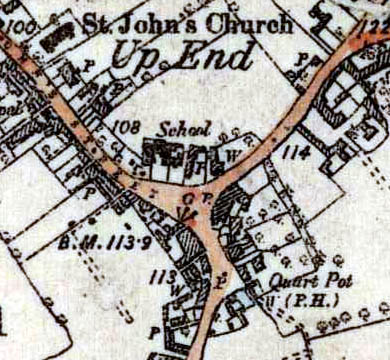The Quart Pot Public House Kempston

The Quart Pot public house on the 1st edition Ordnance Survey 6 inches to the mile map of c.1880
The Quart Pot Public House [previously The Flowing Tankard]: Woburn Road, Kempston
This building is known to have existed by 1720 when it was mortgaged [WL518] and it was first referred to as the Quart Pot public house in 1752 when it was sold by the daughters of Thomas Barringer of Kempston, tailor, deceased to Thomas Richards junior for £80 [WL519-520].
Richards died in 1752, devising the Quart Pot to wife his Ann then to their daughter Mary, the wife of Robert Miles [WL518]. By 1781 it was owned by Joseph Waldeck of Cranfield, innholder as he mortgaged it to John Harling in that year for £100 [WL521]. Waldeck died in 1782 having left the Quart Pot to his wife, Ellen. She drew up her will in the same year and devised the property to her niece Ellen Clare, however, she remarried and in 1785 she and her husband, William Haynes of Kempston, blacksmith, mortgaged a cottage in Kempston in occupation of Joseph Clare to Richard Lovesey and William Barns. It is not clear whether or not this is the Quart Pot. Clearly after Ellen Haynes' death the Quart Pot passed to Ellen or Eleanor Clare as in 1800 her daughters and their respective husbands sold it to Bedford brewers Whittingstall & Long for £200 [BD815-815].
After James Whittingstall's death his executors sold his share of the brewery business to his partner William Long in 1803 [WL533]. including the Quart Pot, then in occupation of John Dudley. Sir William Long, as he became, died in 1841 and his business was taken over by his son-in-law, Robert Newland of Kempston. Newland's son Bingham Newland carried the business on after the death of his father and on his death in 1873 the business was sold at auction and bought by Bedford brewer Thomas Jarvis. Interestingly the sale catalogue [GA487] notes that the Quart Pot had previously been called the Flowing Tankard.
The Quart Pot is last mentioned in 1881 and by 1885 the last known licensee, Amos Hull, is listed as a baker. The 1st edition Ordnance Survey 6 inch to the mile map shows that the public house lay either wholly or partially on the site of the late Duke public house in Woburn Road. A bundle of deeds for land which became the clubroom of the Duke in 1901 had, on the envelope containing them, a reference to the site having been the Quart Pot.
Sources:
- WL518: recital of mortgage: 1720;
- WL518: recital of assignment of mortgage: 1723;
- WL518: assignment of premises: 1752;
- WL519-520: conveyance: 1752;
- WL521: mortgage: 1781;
- BD815-816: conveyance: 1803;
- WL533: one of properties purchased by Sir William Long from Whittingstall: 1803;
- CLP13: register of Alehouse licences: 1822;
- PSB1/1 p.3: licensee John Dudley: 1829 - 1832;
- PSB1/1 p.317: licensee Thomas Robinson 1834;
- GA487: sale catalogue of brewery and licensed premises formerly belonging to Sir William Long: 1873;
- WL647: one of properties of Sir William Long sold to Thomas Jarvis: 1874
List of Licensees: note that this is not a complete list. Italics indicate licensees whose beginning and/or end dates are not known:
1781: Joseph Waldeck;
1800-1829: John Dudley;
1834-1862: Thomas Robinson;
1863: Joseph James;
1864-1881: Amos Hull